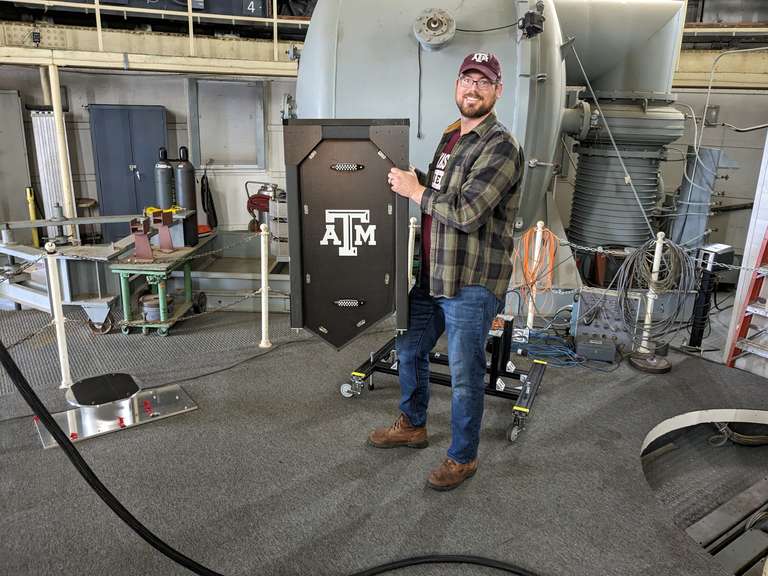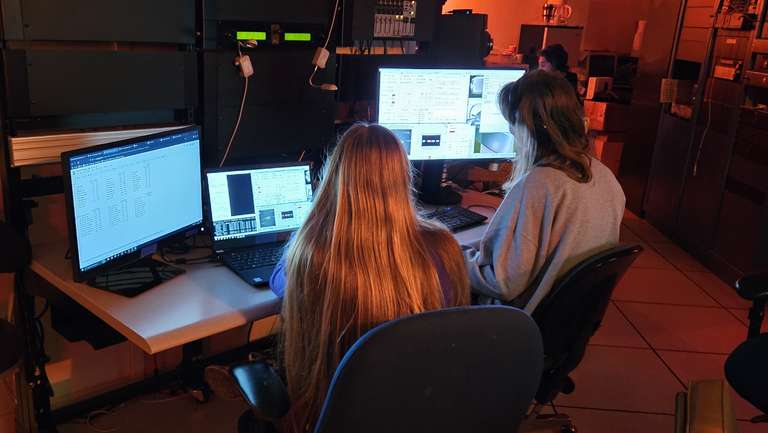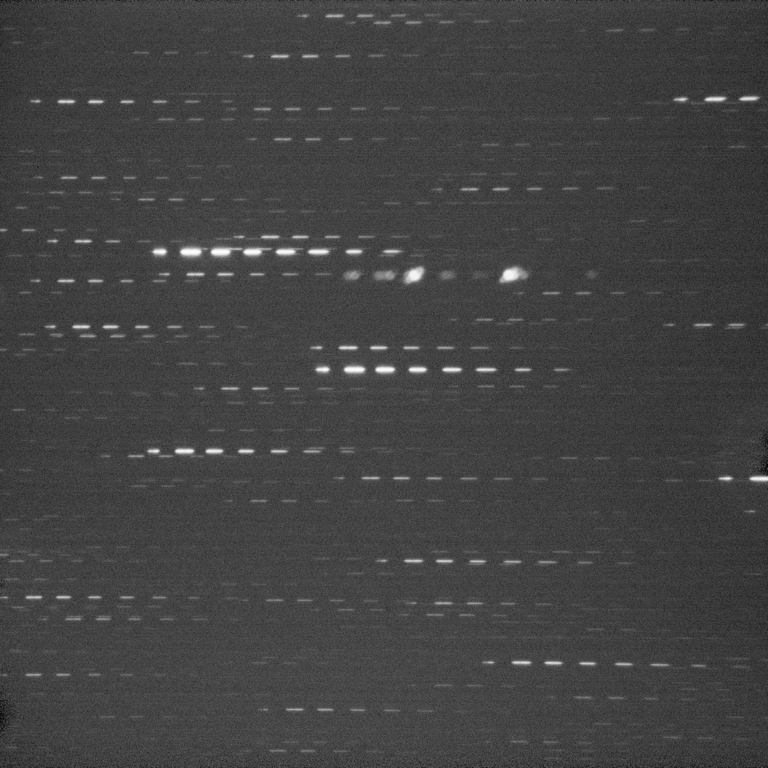ETSI
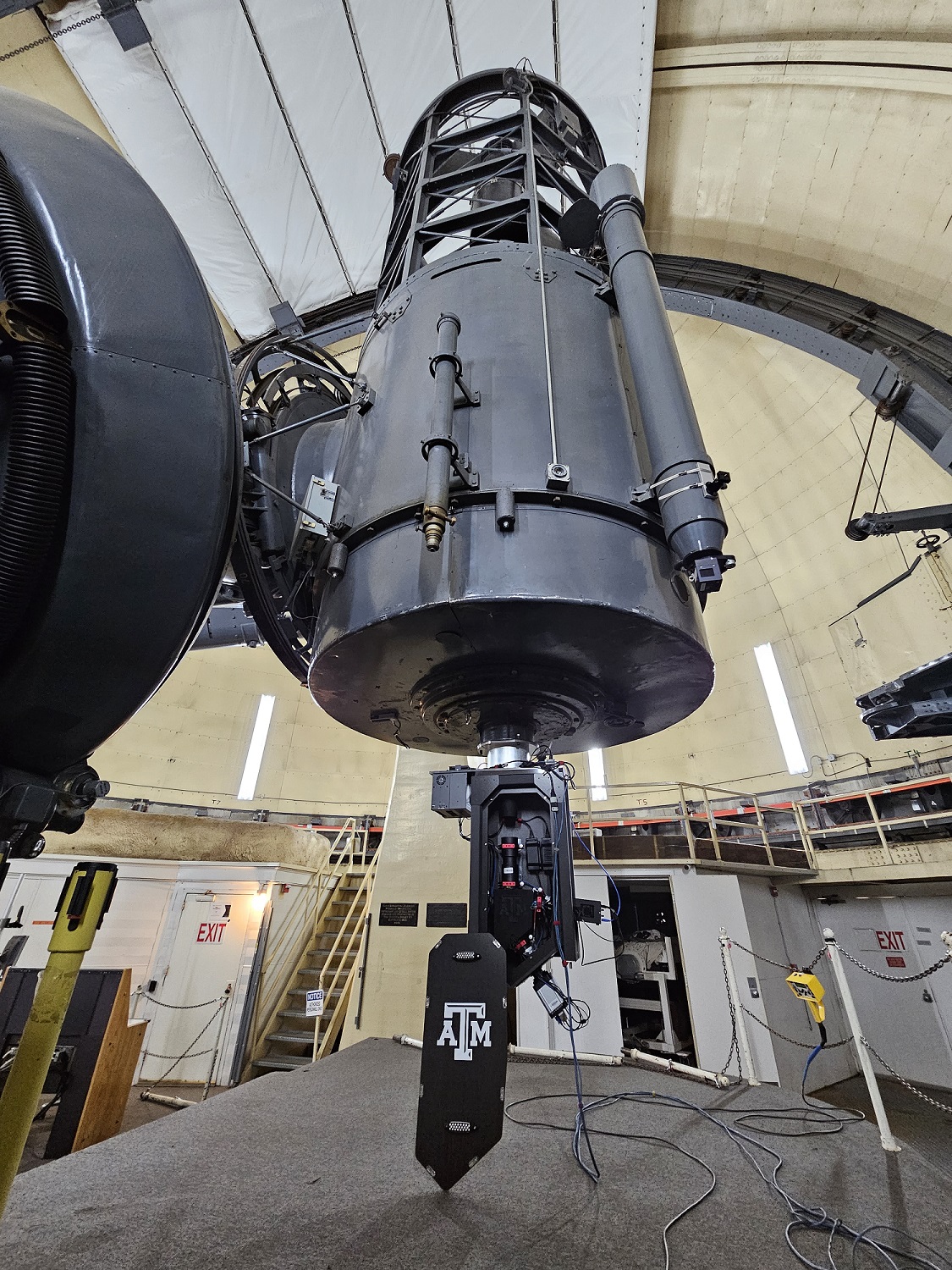
The Exoplanet Transmission Spectroscopy Imager (ETSI) instrument is designed for taking transmission spectra of transiting exoplanets, but it has also been used to observe supernovae, nebulae, galaxies, and the occultations of Titan and Uranus. Since its commissioning in 2022, ETSI has operated on McDonald Observatory's 82" Otto Struve telescope for hundreds of nights by many different people in the astronomy community.
Anyone in the astronomy community can sign up to use ETSI at McDonald Observatory by following the instructions in the McDonald Observatory Call for Proposals.
The WoodNext Foundation has generously provided funding so we can make significant upgrades to ETSI and support observing campaigns over the next three years.
ETSI amalgamates a low resolution slitless prism spectrometer with custom multiband filters to simultaneously image 15 spectral bandpasses between 430 nm and 975 nm with an average spectral resolution of R = λ/∆λ ≈ 20. This enables a new technique called common-path multi-band imaging (CMI), which is used to observe transmission spectra of exoplanets transiting bright (V<14th mag.) stars. ETSI is capable of near photon-limited observations, with a systematic noise floor on par with the Hubble Space Telescope and below the atmospheric amplitude scintillation noise limit. ETSI requires only moderate telescope apertures (~2 m) and is capable of characterizing the atmospheres of dozens of exoplanets and other objects per year, enabling selection of the most interesting targets for further follow up with other ground and space-based observatories.
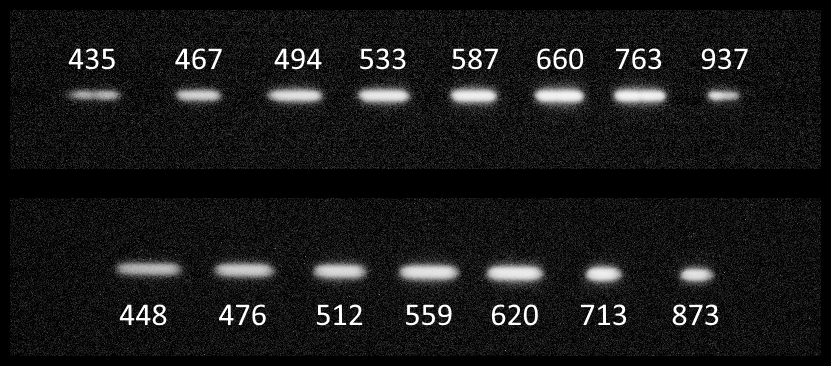
Once an image sequence is obtained, either over the course of hours for a transiting planet or just a few minutes each day for a supernova, we use a self-referencing differential photometric technique to eliminate sources of uncertainty from non-common path sources such as atmospheric scintillation, instrumental effects, and telescopic effects. Each spectral band of the science star is referenced to another spectral band of the same science star. This self-referential photometry eliminates nearly all common-path systematics and allows for a theoretical differential photometric precision on the order of 10 − 25 ppm.
ETSI Instrument Parameters
| *Based on prototype on-sky testing | ||||
| ETSI Parameter | Value | |||
| Wavelength Coverage | 430-975 nm | |||
| Resolution | λ/Δλ = 20 | |||
| Number of Spectral Bands | 15 | |||
| Field of View | 6.2' x 6.2' | |||
| Plate Scale | 0.18"/px | |||
| Photometric Accuracy (1σ, 20min Vstar = 7.5) | 250ppm* | |||
Concept
ETSI makes use of a novel instrument technique called SIMPSS (single image multi-band photometry with slitless spectroscopy) to collect spectral information during exoplanet transits at low resolutions (R = λ/Δλ ≈ 20). The instrument can do this by using a novel picket fence multi-band interference filter followed by a prism to separate the spectral bands. A detector images the dispersed color bands, and a second detector and prism set can be used to image the bands that are reflected (rather than transmitted) by the multi-band interference filter.
ETSI has 7 and 8 bands on the reflected detector and transmitted detector respectively, but up to 25 bands across the visible spectrum is possible. The layout of a SIMPSS instrument with a 25-band filter is shown below, along with an example on-sky image of HD189733 taken with our prototype SIMPSS instrument, which uses a commercially available 5-band Alluxa filter.

Design
ETSI has a five-element collimator and two identical six-element cameras. The collimator is a reverse telephoto with the five lenses separated into three groups. The multi-chroic is located at the pupil and is responsible for the inital splitting of the light into eight transmitted bands and seven reflected bands. In order to perform photometry on each individual band, prisms (N-SF5 glass type) disperse the light, separating the filter bands into distinct PSFs, which results in the unique dashed-line appearance of ETSI images. Before each camera is a clean-up filter that improves out of band blocking and cut-on/off sharpness for each of the fifteen filter bands.
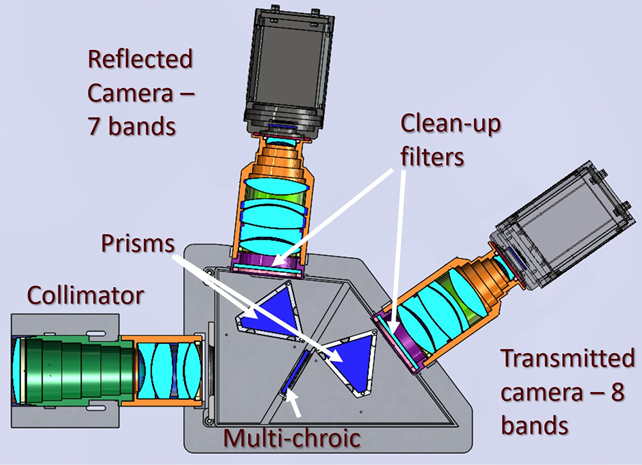
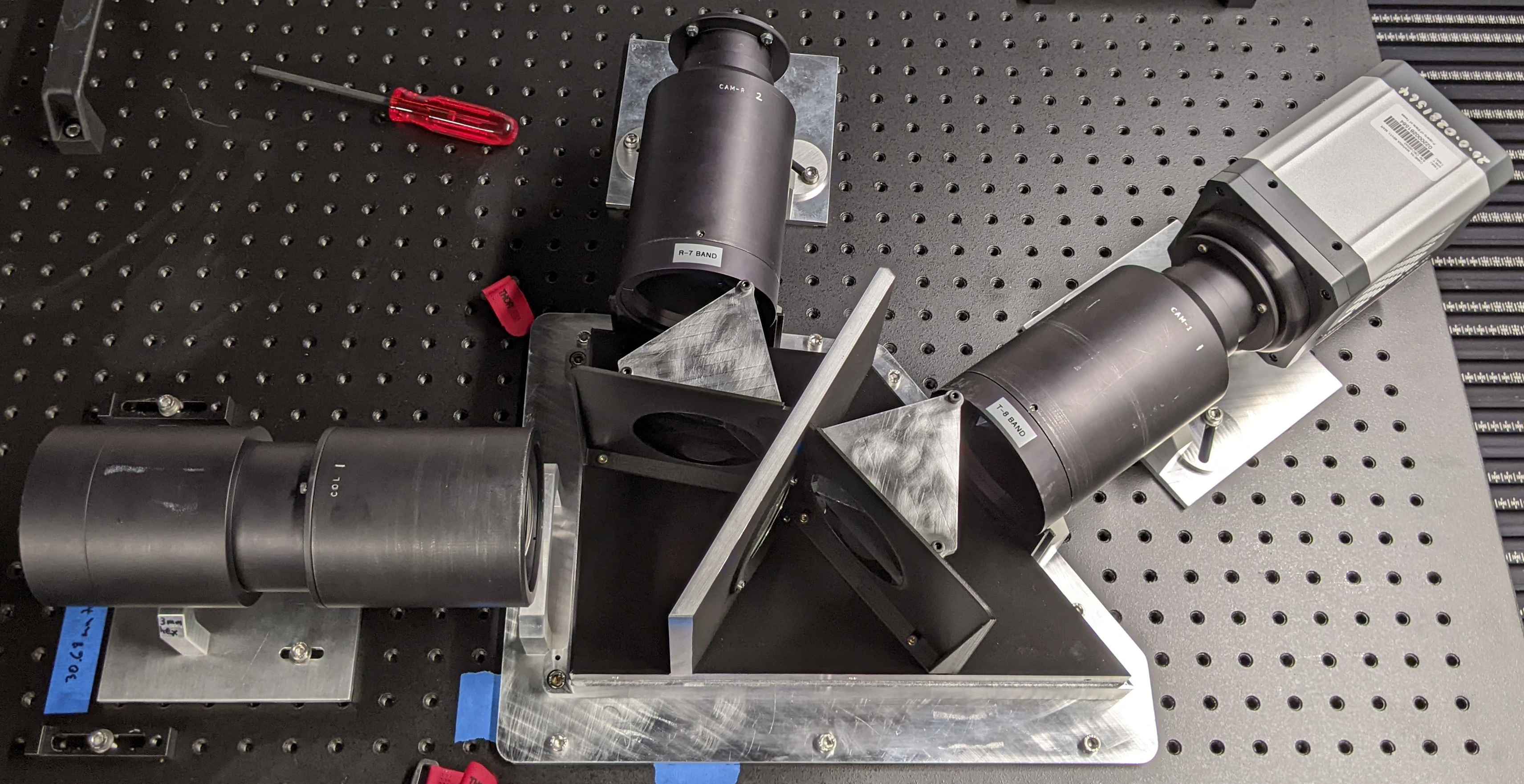
The filter bands were chosen to coincide with exoplanet atmospheric features. We modeled dozens of exoplanet atmospheres using Exo-Transmit and aligned the spectral bands with detectable molecular and atomic absorption features. Two small portions of the spectrum (680-697 nm and 797-847 nm) are blocked completely in order to maintain adequate spacing between spectral bands of interest on the detectors.
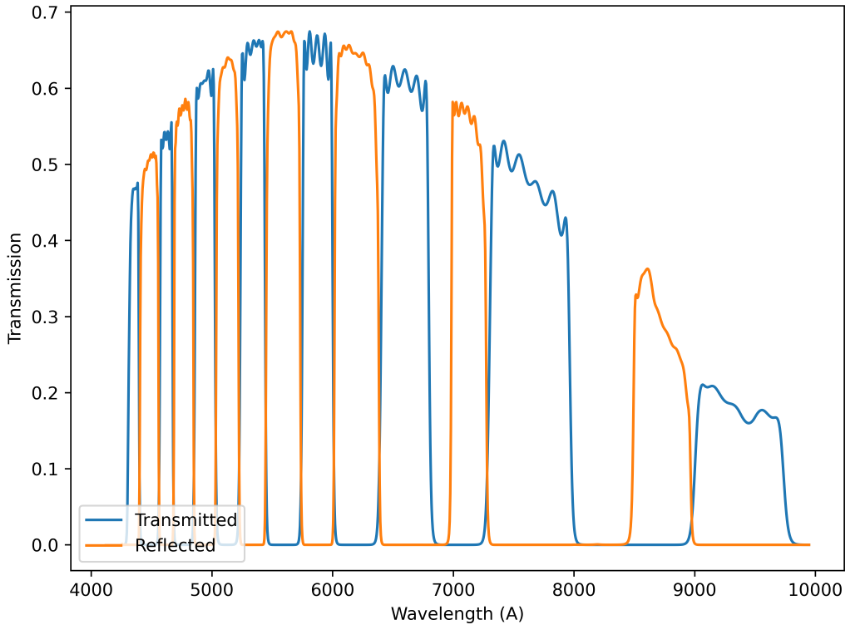
A lightweight carbon fiber frame holds all the elements of ETSI. A mounted computer runs Windows and the ETSI control software, programmed in Python. The optics are sealed inside a specially designed 3D-printed case. An Andor Marana sCMOS detector and Teledyne Kuro sCMOS detector collect the light from the transmitted channel and reflected channel respectively.

Scientific Results
Light curves have been investigated for several objects using data obtained by the instrument 2022-2025 by Texas A&M researchers, graduate students, and undergraduate student, as well as researchers from outside of Texas A&M.
HD 94883
HD 94883 is an A2 star observed at a cadence of 0.2 s over a baseline of ~1.5 hours. The change in magnitude for each bandpass was found to be consistent with a flat line (R^2~0), and the mean change in color of HD 94883 was found to be 0.05% over 90 minutes of observations, which is consistent with expectations and is expected to improve as the data reduction methods are finalized.
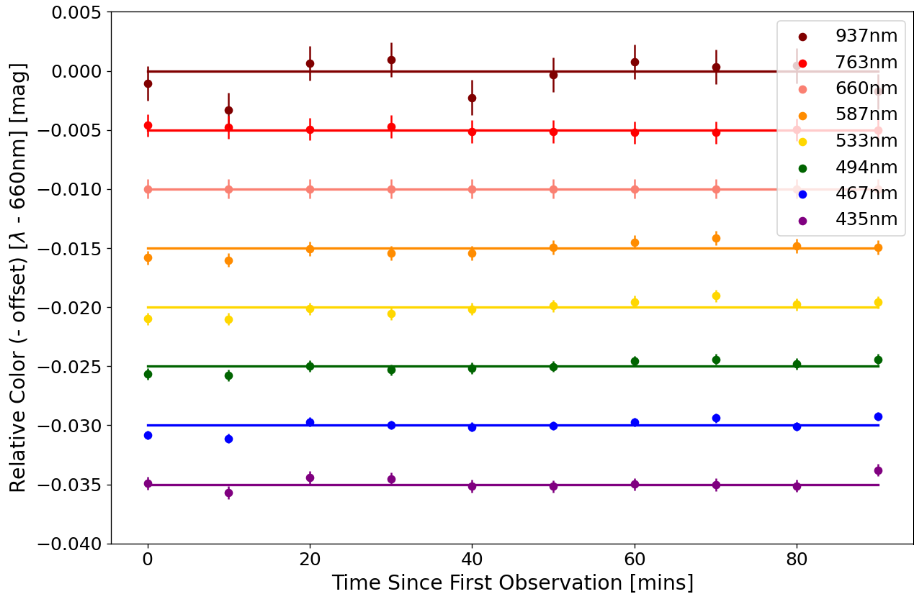
Transit of WASP-33b
Using ETSI's common path multi-band imaging (CMI) method allows astronomers to use the star itself to remove the systematics, which is more reliable than the traditional methods of using comparison star as described in Oelkers, et al. 2025, AJ, 169, 134.
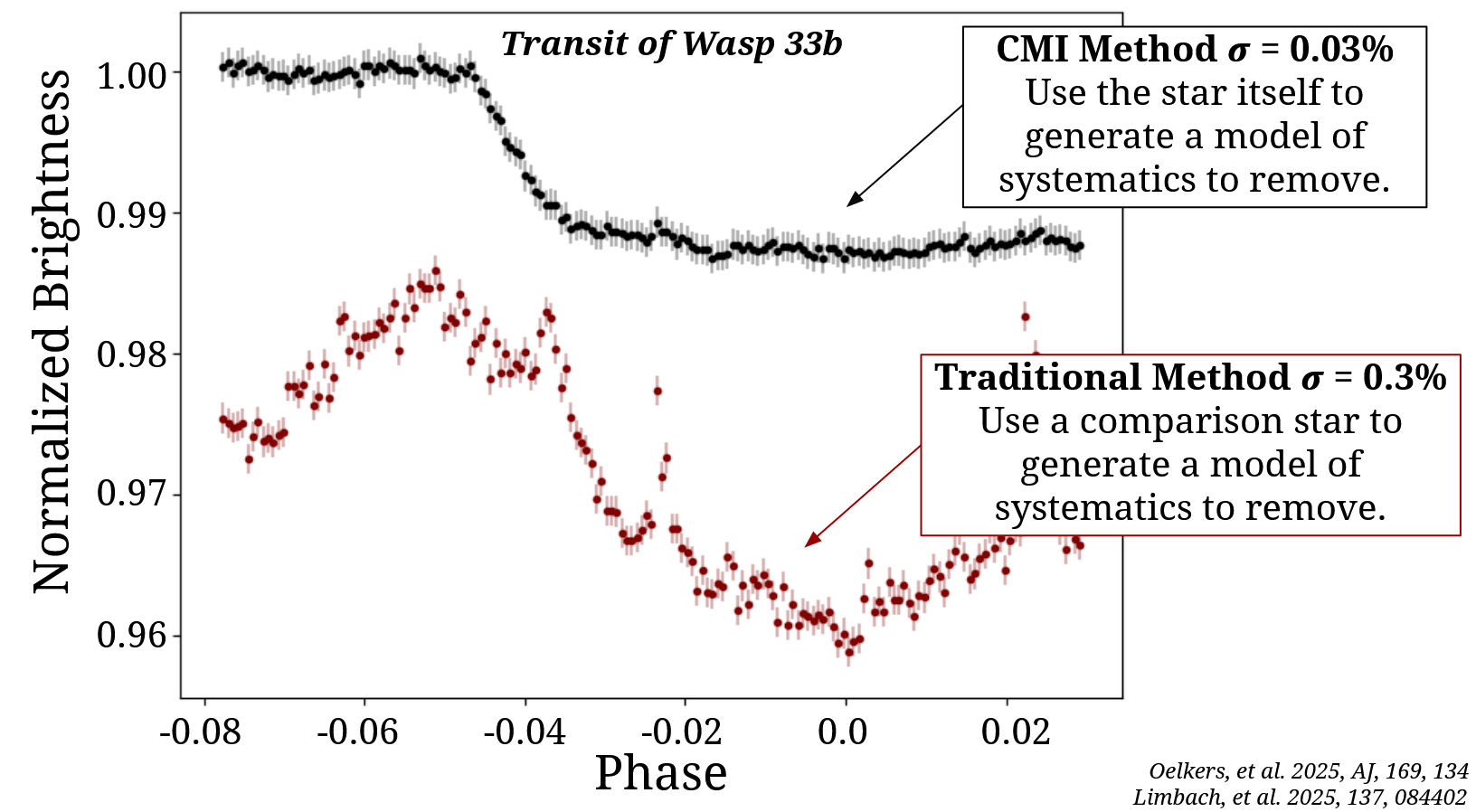
Occultations of Titan and Uranus
In 1944, McDonald's 82" Otto Struve telescope was used to detect methane in the atmosphere of Titan. On July 8, 2022, we were able to observe the occultation of Titan in front of HIP 107569 to also study Titan's atmosphere.

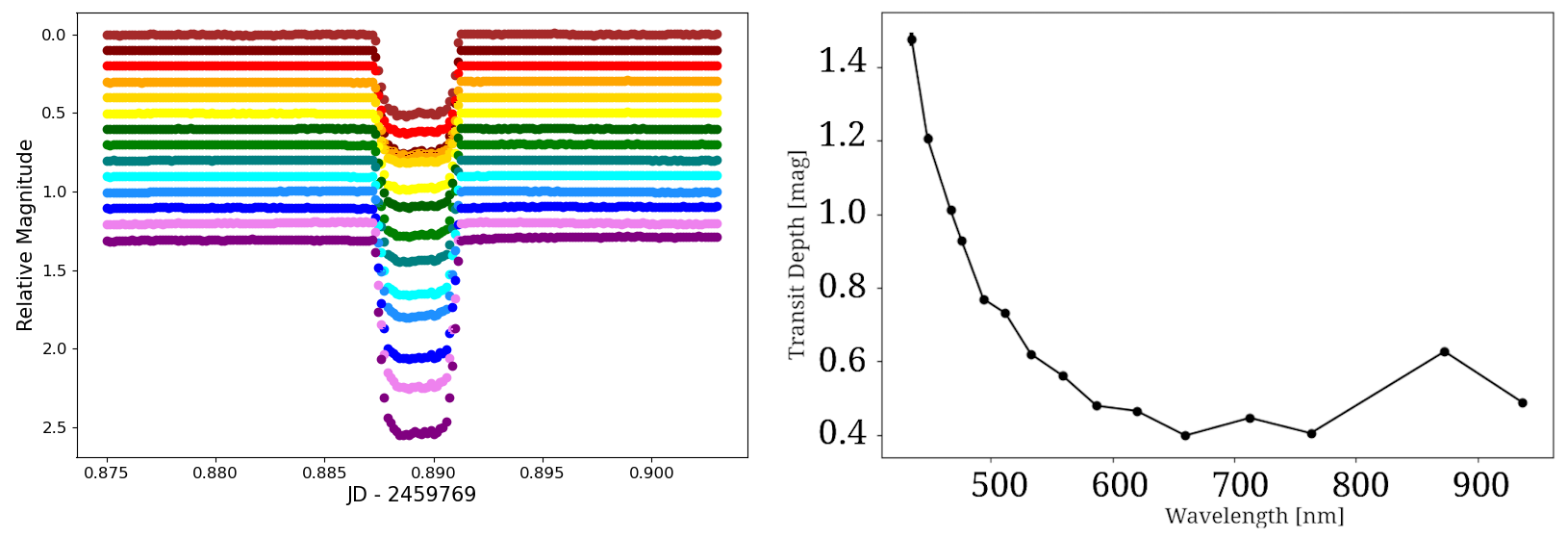
On April 7 2025, a team from NASA used ETSI to study Uranus during its occultation. ETSI's high framerate allowed the team to capture the moments when Uranus's rings moved in front of the star.

Further observations of dozens of objects have been conducted over the course of 2022 to 2025, and the results are still in the works. Stay tuned!
ETSI in the News
 | NASA team uses ETSI to study Uranus |
 | ETSI is featured in: Alluxa Develops |
Publications
Ground-based reconnaissance observations of 21 exoplanet atmospheres with the Exoplanet Transmission Spectroscopy Imager
The Astronomical Journal, Volume 169, Issue 3, article id. 134, 22 pp. (2025).
Ryan J. Oelkers, Luke M. Schmidt, Erika Cook, Mary Anne Limbach, D. L. DePoy, J. L. Marshall, Jimmy Ardoin, Mitchell Barry, Evan Batteas, Alexandra Boone, Brant Conway, Silvana Delgado Adrande, John D. Dixon, Enrique Gonzalez-Vega, Alexandra Guajardo, Landon Holcomb, Christian Lambert, Shravan Menon, Divya Mishra, Jacob Purcell, Zachary Reed, Nathan Sala, Noah Siebersma, Nhu Ngoc Ton, Raenessa M. L. Walker, Z. Franklin Wang, and Kaitlin Webber, https://iopscience.iop.org/article/10.3847/1538-3881/ada557
(PDF)
Rapid characterization of exoplanet atmospheres with the Exoplanet Transmission Spectroscopy Imager
Luke M. Schmidt, Ryan J. Oelkers, Erika Cook, Mary Anne Limbach, Darren L. DePoy, Jennifer L. Marshall, Landon Holcomb, Willians Pena, Jacob Purcell, and Enrique Gonzalez Vega, "," Proc. SPIE J. Astron. Telesc. Instrum. Syst. 10(4) 045005 (9 December 2024); https://doi.org/10.1117/1.jatis.10.4.045005
(PDF)
The Exoplanet Transmission Spectroscopy Imager (ETSI), a new instrument for rapid characterization of exoplanet atmospheres
Luke M. Schmidt, Mary Anne Limbach, Erika Cook, D. L. DePoy, Ryan J. Oelkers, J. L. Marshall, Landon Holcomb, Willians Pena, Jacob Purcell, Enrique Gonzalez Vega, "," Proc. SPIE 12184, Ground-based and Airborne Instrumentation for Astronomy IX, 1218486 (29 August 2022); https://doi.org/10.1117/12.2630196
(PDF) (Poster)
The Exoplanet Transmission Spectroscopy Imager (ETSI)
Mary Anne Limbach, Luke M. Schmidt, D. L. DePoy, Jeffrey C. Mason, Mike Scobey, Pat Brown, Chelsea Taylor, Jennifer L. Marshall, "," Proc. SPIE 11447, Ground-based and Airborne Instrumentation for Astronomy VIII, 114477D (13 December 2020); https://doi.org/10.1117/12.2562371
(PDF) (Poster)

